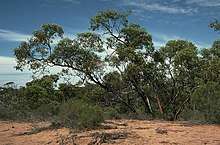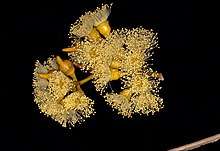Eucalyptus yumbarrana
Eucalyptus yumbarrana, commonly known as the Yumbarra mallee[2] is a species of mallee that is endemic to South Australia. It has rough, flaky bark on the lower trunk, smooth bark above, egg-shaped to lance-shaped adult leaves, flower buds in groups of seven, creamy white to yellow flowers and shortened spherical to cup-shaped fruit.
| Yumbarra mallee | |
|---|---|
 | |
| Eucalyptus yumbarrana in Yumbarra Conservation Park | |
| Scientific classification | |
| Kingdom: | Plantae |
| Clade: | Tracheophytes |
| Clade: | Angiosperms |
| Clade: | Eudicots |
| Clade: | Rosids |
| Order: | Myrtales |
| Family: | Myrtaceae |
| Genus: | Eucalyptus |
| Species: | E. yumbarrana |
| Binomial name | |
| Eucalyptus yumbarrana | |

Description
Eucalyptus yumbarrana is an erect to sprawling mallee that typically grows to a height of 6 m (20 ft), rarely a tree to 8 m (26 ft), and forms a lignotuber. It has fibrous-stringy bark on the trunk and lower stems, smooth grey to cream-coloured bark above and that is shed in ribbons that often hang in the upper branches. Young plants and coppice regrowth have stems that are square in cross-section, and leaves that are dull bluish green, elliptical to egg-shaped, or round, 38–120 mm (1.5–4.7 in) long and 25–55 mm (0.98–2.17 in) wide. Adult leaves are the same glossy green on both sides, egg-shaped to lance-shaped or broadly lance-shaped, 70–130 mm (2.8–5.1 in) long and 20–50 mm (0.79–1.97 in) wide on a petiole 15–30 mm (0.59–1.18 in) long. The flower buds are arranged in leaf axils on an unbranched peduncle 7–20 mm (0.28–0.79 in) long, the individual buds on pedicels 4–7 mm (0.16–0.28 in) long. Mature buds are oval, 12–20 mm (0.47–0.79 in) long and 7–9 mm (0.28–0.35 in) wide with a beaked operculum 8–13 mm (0.31–0.51 in) long. Flowering occurs from July to October and the flowers are creamy white to yellow. The fruit is a woody shortened spherical to cup-shaped capsule 8–12 mm (0.31–0.47 in) long and 8–10 mm (0.31–0.39 in) wide with the valves protruding.[3][4][5][6]
Taxonomy and naming
Eucalyptus yumbarrana was first formally described in 1979 by Clifford David Boomsma in the Journal of the Adelaide Botanic Gardens from specimens collected in Yumbarra Conservation Park in 1977.[7][8] The specific epithet (yumbarrana) is a reference to the type location.[8]
Distribution and habitat
Eucalyptus yumbarrana is often found in the swales between sand dunes in open shrubland in arid areas in the Yumbarra and Koonibba areas.[4][5]
See also
References
- "Eucalyptus yumbarrana". Australian Plant Census. Retrieved 25 January 2020.
- Dean Nicolle. "Native Eucalypts of South Australia". Retrieved 22 October 2016.
- "Eucalyptus yumbarrana (Myrtaceae) Yumbarra Mallee". Seed of South Australia. Botanic Gardens of South Australia. Retrieved 25 January 2020.
- "Eucalyptus yumbarrana". Euclid: Centre for Australian National Biodiversity Research. Retrieved 27 May 2020.
- Chippendale, George M. "Eucalyptus yumbarrana". Australian Biological Resources Study, Department of the Environment and Energy, Canberra. Retrieved 25 January 2020.
- Nicolle, Dean (2013). Native Eucalypts of South Australia. Adelaide: Dean Nicolle. pp. 74–75. ISBN 9780646904108.
- "Eucalyptus yumbarrana". APNI. Retrieved 25 January 2020.
- Boomsma, Clifford D. (1979). "Four new species of Eucalyptus L'Herit. from South Australia" (PDF). Journal of the Adelaide Botanic Gardens. 1 (6): 366–368. Retrieved 25 January 2020.